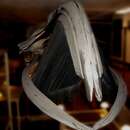en
names in breadcrumbs


The species associated with this page are major players in the pelagic ecosystem of the Stellwagen Bank National Marine Sanctuary. Stellwagen Bank is an undersea gravel and sand deposit stretching between Cape Cod and Cape Ann off the coast of Massachussets. Protected since 1993 as the region’s first National Marine Sanctuary, the bank is known primarily for whale-watching and commercial fishing of cod, lobster, hake, and other species (Eldredge 1993).
Massachusetts Bay, and Stellwagen Bank in particular, show a marked concentration of biodiversity in comparison to the broader coastal North Atlantic. This diversity is supported from the bottom of the food chain. The pattern of currents and bathymetry in the area support high levels of phytoplankton productivity, which in turn support dense populations of schooling fish such as sand lance, herring, and mackerel, all important prey for larger fish, mammals, and seabirds (NOAA 2010). Sightings of many species of whales and seabirds are best predicted by spatial and temporal distribution of prey species (Jiang et al 2007; NOAA 2010), providing support for the theory that the region’s diversity is productivity-driven.
Stellwagen Bank is utilized as a significant migration stopover point for many species of shorebird. Summer visitors include Wilson’s storm-petrel, shearwaters, Arctic terns, and red phalaropes, while winter visitors include black-legged kittiwakes, great cormorants, Atlantic puffins, and razorbills. Various cormorants and gulls, the common murre, and the common eider all form significant breeding colonies in the sanctuary as well (NOAA 2010). The community of locally-breeding birds in particular is adversely affected by human activity. As land use along the shore changes and fishing activity increases, the prevalence of garbage and detritus favors gulls, especially herring and black-backed gulls. As gull survivorship increases, gulls begin to dominate competition for nesting sites, to the detriment of other species (NOAA 2010).
In addition to various other cetaceans and pinnipeds, the world’s only remaining population of North Atlantic right whales summers in the Stellwagen Bank sanctuary. Right whales and other baleen whales feed on the abundant copepods and phytoplankton of the region, while toothed whales, pinnipeds, and belugas feed on fish and cephalopods (NOAA 2010). The greatest direct threats to cetaceans in the sanctuary are entanglement with fishing gear and death by vessel strikes (NOAA 2010), but a growing body of evidence suggests that noise pollution harms marine mammals by masking their acoustic communication and damaging their hearing (Clark et al 2009).
General threats to the ecosystem as a whole include overfishing and environmental contaminants. Fishing pressure in the Gulf of Maine area has three negative effects. First and most obviously, it reduces the abundance of fish species, harming both the fish and all organisms dependent on the fish as food sources. Secondly, human preference for large fish disproportionately damages the resilience of fish populations, as large females produce more abundant, higher quality eggs than small females. Third, by preferentially catching large fish, humans have exerted an intense selective pressure on food fish species for smaller body size. This extreme selective pressure has caused a selective sweep, diminishing the variation in gene pools of many commercial fisheries (NOAA 2010). While the waters of the SBNMS are significantly cleaner than Massachusetts Bay as a whole, elevated levels of PCBs have been measured in cetaceans and seabird eggs (NOAA 2010). Additionally, iron and copper leaching from the contaminated sediments of Boston Harbor occasionally reach the preserve (Li et al 2010).